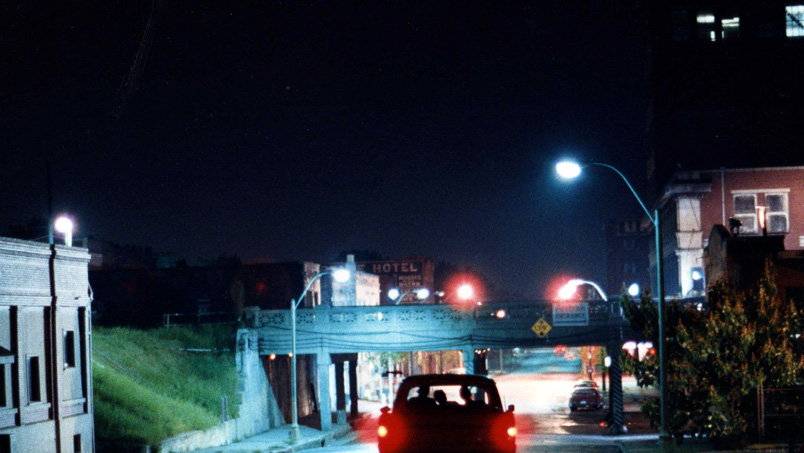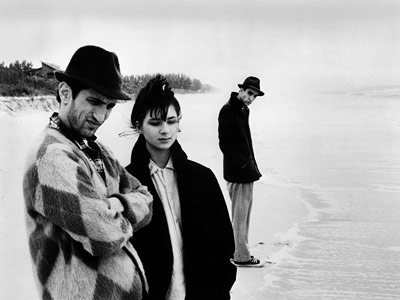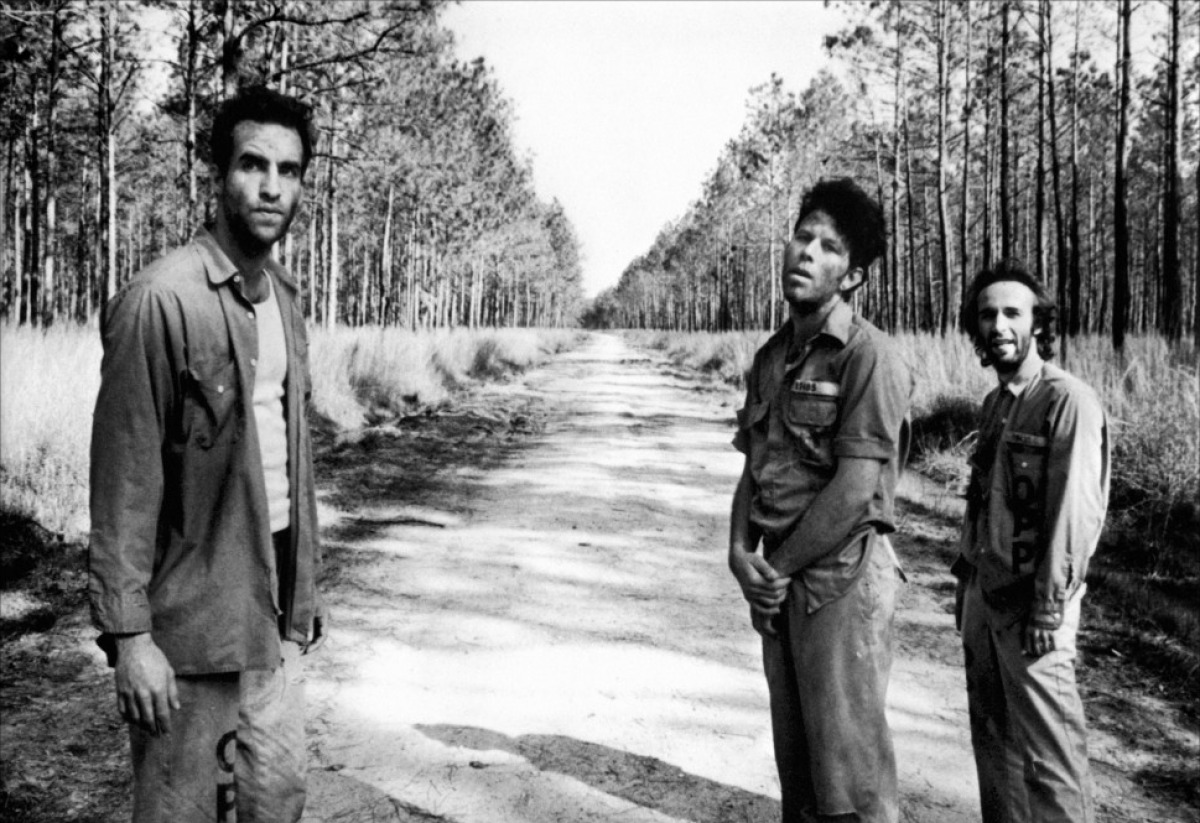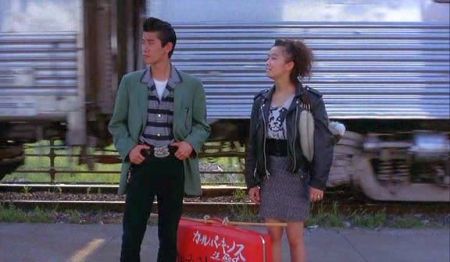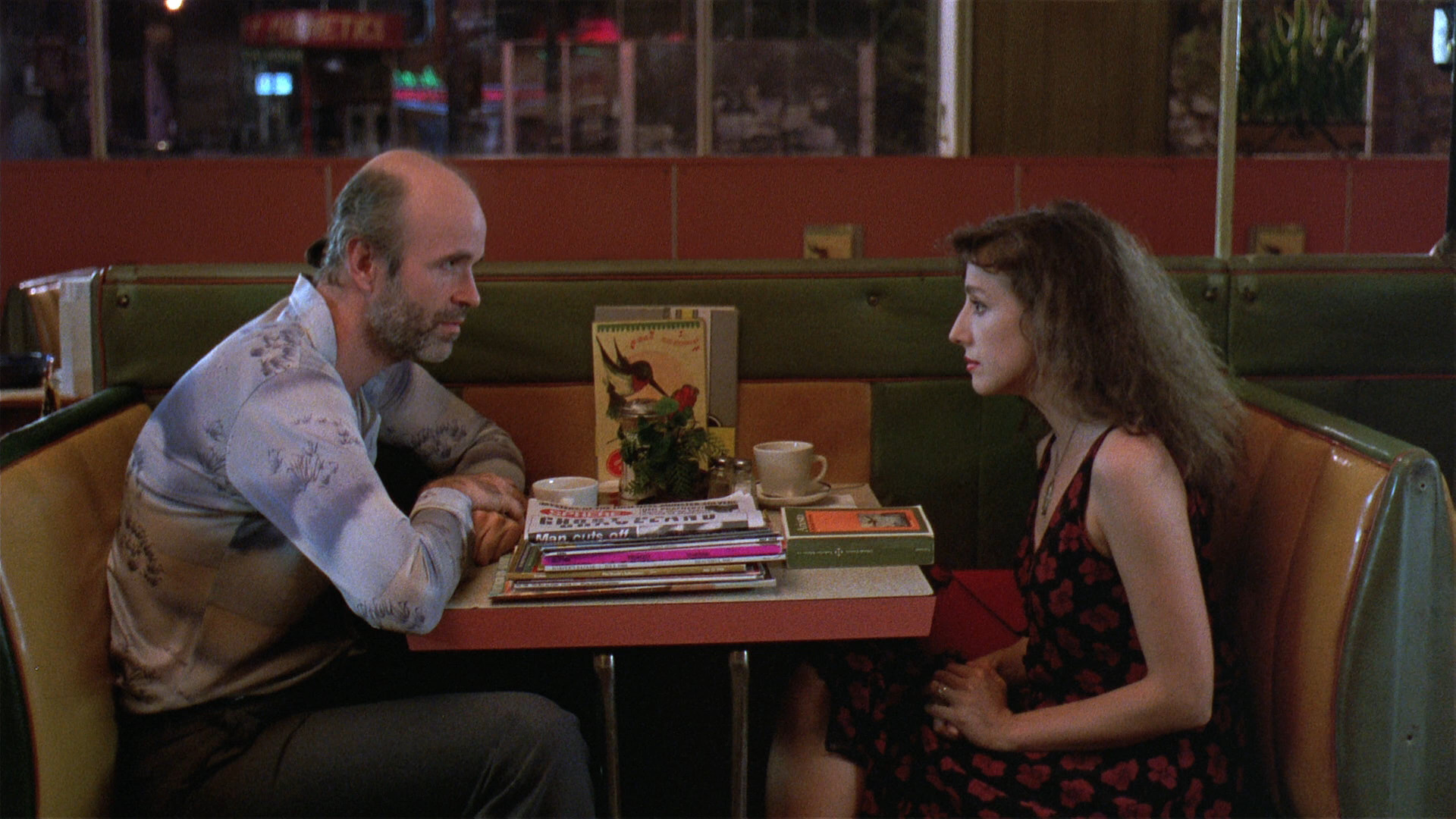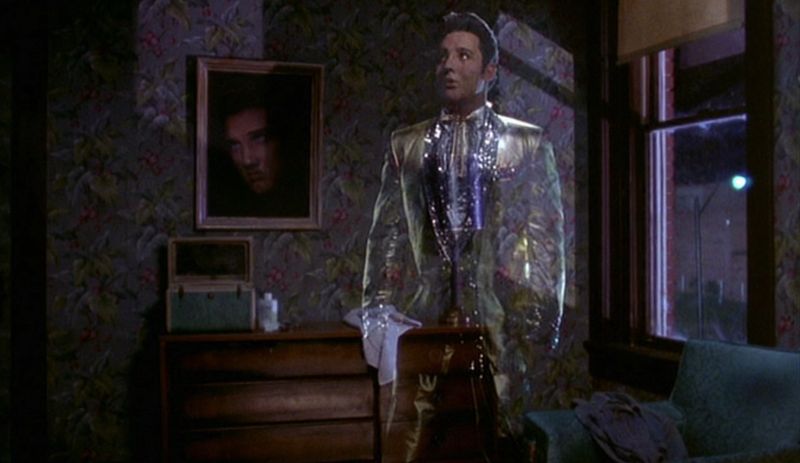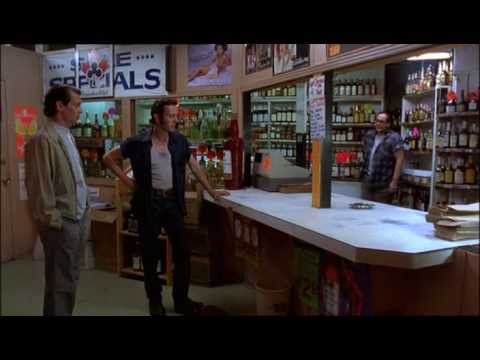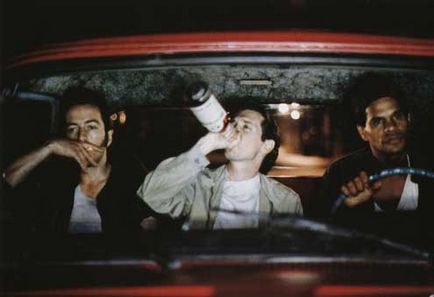From the Chicago Reader (February 9, 1990). — J.R.
MYSTERY TRAIN
** (Worth seeing)
Directed and written by Jim Jarmusch
With Youki Kudoh, Masatoshi Nagase, Screamin’ Jay Hawkins, Cinque Lee, Nicoletta Braschi, Elizabeth Bracco, Joe Strummer, and Rick Aviles.
Mastery is a rare commodity in American movies these days, in matters both large and small, so when a poetic master working on a small scale comes into view, it’s reason to sit up and take notice. Jim Jarmusch’s second feature, Stranger Than Paradise, won the Camera d’Or at Cannes in 1984 and catapulted him from the position of an obscure New York independent with a European cult following — on the basis of his first feature, Permanent Vacation (1980) — to international stardom.
As the first — and so far only — filmmaker informed by the New York minimalist aesthetic to make a sizable mainstream splash, Jarmusch had a lot riding on his next films, and he has acquitted himself admirably. He hasn’t sold out to Hollywood or diluted his style, and, unlike most of the few other contemporary American independents to make it big, he has managed to maintain rigorous control over every aspect of his work, from script to production to distribution. (His friend Spike Lee has approached this ideal, but working with major studios, as Lee has on School Daze and Do the Right Thing, hasn’t afforded him quite the same degree of autonomy. And neither Lee nor any other American filmmaker of comparable renown owns every feature he has made, as Jarmusch does — a position of power that makes him literally unique.)
To call Jarmusch a master on a small scale is not by any means to downgrade his work, but it does place a special burden on it. Working in a carefully pared-down style with characters who are either semiarticulate or articulate only in languages most of us don’t understand — and letting these characters, not plot, carry his pictures — Jarmusch maps out a special arena where every filmic and personal gesture, every camera angle, camera movement, and line of dialogue counts, and counts for more than it would in a more conventional movie. A false move in a film by Spike Lee or Alex Cox can be written off as a lapse or a throwaway detail, but it is part of the integrity of Jarmusch’s filmmaking that nothing is expendable. His hip miniatures are like high-wire acts where stumbling is tantamount to falling, so it’s not too surprising that they usually depend on the same tried-and-true maneuvers, regardless of how many formal, thematic, and emotional departures are broached in each new feature. Plus ça change, plus c’est la meme chose could be the motto of Jarmusch’s third and fourth features, for better and for worse. (Whether or not he’ll break with this pattern on his next picture — a black-and-white Western — remains to be seen.)
The fact that Jarmusch’s cinematic influences mainly come from abroad while his subjects are strictly American gives his films a kind of international sophistication that generally can’t be found in Hollywood products. (As his recent list of the ten best films of the 80s in Premiere magazine demonstrated, his taste in film is unusually discerning.) At his best, beginning with his second feature, he has used non-American characters as lenses to show us some of our own peculiarities — leading to a kind of two-way discourse about how we see others and how others see us. In order for this to work, however, Jarmusch has had to understand enough about his characters — Americans and non-Americans alike — in order to make this discourse informed and pointed. Within his chosen limits, he succeeded in this task in both Stranger Than Paradise and Down by Law. In Mystery Train, his latest feature, the results are more uneven: some of the characters are beautifully imagined and realized, while others seem drawn from a more familiar stockpile, designed for reuse rather than discovery.
Permanent Vacation had ideas as well as some wit and charm, but it lacked the concentration that gave Stranger Than Paradise its lasting impact: the extended one-take sequences, the exquisitely timed blackouts and stretches of black leader between them, the grungy allure and delicately nuanced interplay of the three leads (Richard Edson, John Lurie, Eszter Balint), the relative uniformity of Tom Di Cillo’s grayish cinematography in relation to a shifting landscape (urban New York, suburban Cleveland, rural Florida), the clipped humor of the parsimonious dialogue. Jarmusch’s comic hipness certainly hovered around the edges of Permanent Vacation and informed some of its scenes, but in Stranger Than Paradise it blossomed into something more sad, sweet, and durable — the relationship between two male layabouts and the young Hungarian woman they adore but are too shy and macho to express their feelings to directly.
Down by Law (1986) repeated certain aspects of Stranger Than Paradise — which brought Jarmusch some complaints — with some significant differences. Another three-part black-and-white comedy about two hapless Americans (John Lurie and Tom Waits) and an unassimilated but resourceful European (Roberto Benigni) converging, coexisting, and diverging in changing yet similar landscapes (this time the Louisiana settings of New Orleans, a prison, a swamp, and a forest), the film made use of a similar low-life milieu and the same sort of strategic odd-shaped pauses in the dialogue. But the formal and thematic differences were in many cases just as significant as the similarities.
Both movies were fundamentally about freedom and confinement, but the stylistic moves articulating this dialectic were shaped quite differently, and the thematic consequences of this difference were equally marked. The one-take, one-angle-per-scene style of Stranger Than Paradise was jettisoned for a more strategic use of framing combined with deep focus that suggested different perspectives on the same scenes (initially associated with the women living with Waits and Lurie, and later linked with Benigni); Jarmusch used a new cinematographer, Robby Müller, and with him came a more orchestrated and thought-out camera style.
While the convergence of the three characters in Stranger Than Paradise was willed, and their divergence accidental, Down by Law reversed this pattern by landing its three heroes in the same prison cell, and eventually having them go separate ways. Far from being another (albeit male) version of Balint, Benigni was quite the reverse — ebullient and demonstrative where Balint was withdrawn and deadpan. Finally, the fact that Benigni wound up as part of a romantic couple — after encountering another Italian (Nicoletta Braschi) in a cottage in the middle of a swamp — gave the whole film a fairy-tale ambience that was totally absent from Stranger Than Paradise, as well as a kind of optimism that was quite out of keeping with the more absurdist plots of the previous films.
With Mystery Train, the question of differences and similarities with Jarmusch’s last two pictures becomes even more complex. Returning to color for the first time since Permanent Vacation (with a much more carefully controlled palette), and working again with Müller, he once again uses a three-part structure, but this time each part centers on a separate set of characters, and all three take place in Memphis during the same 24 hours. Characters from the three parts do overlap, but apart from a character in part two and her boyfriend who turns up in part three, this overlapping is coincidental.
All three parts are set in the same rundown section of Memphis, not far from a train station — one of the principal formal elements in the film, which Jarmusch uses as a kind of theme and variations. This brings back the notion from Down by Law of different perspectives on the same events and locations, but it takes a different form here that’s roughly analogous to three-dimensional chess. Since each fresh perspective occurs as part of a separate story, it is only after the film is over, when we can mentally superimpose the three stories, that the cubistic effect fully takes hold.
One of Jarmusch’s stated inspirations for the film is Chaucer’s Canterbury Tales — separate stories being told during a religious pilgrimage — and he even takes care to stage the first Memphis street scene on Chaucer Street, and point this out in the dialogue. It’s a connection that makes a certain (if limited) amount of sense in the first part, entitled “Far From Yokohama,” about a young Japanese couple (Masatoshi Nagase and Youki Kudoh) traveling across the U.S. by train. Given their fervor for rock icons associated with Memphis — he prefers Carl Perkins while she stands by Elvis — their trip resembles a religious pilgrimage: specifically to the Sun studios (which we see) and to Graceland (which we don’t). (Their next scheduled stop after Memphis is New Orleans, where they plan to visit Fats Domino’s house.) But to all appearances, that’s as far as the Chaucer analogy goes: the other two stories have nothing to do with a pilgrimage, and while the characters in Chaucer recount their own stories, the characters here — with one exception — don’t.
“Far From Yokohama” is full of charm and humor; Jarmusch’s tenderness toward Jun and Mitzuko includes a warm understanding of their emotional dynamics as a couple — his poker-faced stolidity and her affectionate aggressiveness — and the performances of Nagase and Kudoh, almost exclusively in Japanese (with subtitles), are consistently engaging. This section, which introduces us to the train of the title and to the section of Memphis that we are to revisit in the next two parts — including the run-down Arcade Hotel — also introduces us to a vision of the south that is acutely and effectively trained on two contrasting qualities, lushness and decay. (The lushness is apparent in the hills covered by kudzu that flank the approaching and retreating train in the film’s opening and closing shots; the decay is evident in, among other locations, the ruins of a movie theater and a filling station.)
Problems begin to arise when the couple visit the Sun studios and a tour guide runs through a mechanical, memorized spiel: Mitzuko’s expression of disbelief at this jabbering is funny, but the speech itself and its delivery are slightly off, not quite convincing either as satire or as straight observation. In the second section, “A Ghost,” an even bigger problem in plausibility crops up when a black news vendor tells a white customer he can “change history,” and in the same jivey manner convinces the heroine of this episode, Luisa (Down by Law‘s Nicoletta Braschi), to buy an additional newspaper and a stack of magazines. The vendor’s patter may be funny, but in relation to the southern setting it is totally wrong — just as the comic byplay between the black night clerk (Screamin’ Jay Hawkins) and bellboy (Cinque Lee) with various white customers at the Arcade Hotel, which figures in all three sections, is usually not believable either. I am admittedly more sensitive to these nuances than most, having grown up in the south, but black and white southerners don’t speak to one another this way, and the problem with Jarmusch’s handling of such scenes is that he doesn’t appear to know this.
This problem is analogous to what happened when Bob Rafelson went to Alabama to make Stay Hungry, and when Robert Altman took his cast and crew to Nashville. A director’s lack of familiarity with a locale can theoretically produce a certain freshness of outlook, but it also can lead to serious misrepresentation if he winds up superimposing forms of speech and behavior that he knows from other places on the local populace, or on actors who are meant to be playing locals. When critics acclaimed Nashville for having something profound to say about “America,” they were speaking abstractly rather than concretely, because as far as local detail was concerned, the film was taking place nowhere.
I’m sorry to say that the same strictures apply to Mystery Train, and because of the small scale, in which, as I’ve mentioned, every step counts, the consequences of these miscalculations are even more harmful. As long as we’re seeing Memphis from the viewpoint of foreign tourists — the Japanese couple in “Far From Yokohama,” Luisa in “A Ghost” — we can at least momentarily accept the fact that things look and sound a little cockeyed. But whenever we’re asked to move beyond these viewpoints the balance gets thrown out of kilter; an urban provincialism begins to creep into the picture, and with it a hint of a sensibility that can’t recognize or respond to what’s indigenous and distinct about the region that’s being filmed. (It might also be argued that Jarmusch’s treatment of black characters in all his features demonstrates certain limitations. While his uses of black culture are always appreciative and even celebratory, they generally appear to be circumscribed within a narrow range of assumptions, most of them seemingly derived from the lyrics of blues, R and B, and rock songs.)
Luisa is a widowed newlywed momentarily stranded with her groom’s coffin in the Memphis airport. (This sequence begins with a shot of the coffin, which may remind us that a hearse was the first thing we saw in Down by Law.) Turning up via taxi in the same neighborhood where we previously saw Jun and Mitzuko — which leads to some pleasurable visual rhymes, such as the moment she passes an empty lot where they had lingered — she gives money to a guy who tells her a story about picking up a hitchhiker who proved to be the ghost of Elvis. Then she winds up sharing a room in the Arcade Hotel with a stranger named DeeDee (Elizabeth Bracco), who tells her about coming to Memphis from New Jersey with her brother and her recent breakup with her English boyfriend. Later, after DeeDee goes to sleep, Luisa briefly glimpses and converses with Elvis’s ghost — a funny and delicately handled scene that enhances the film’s overall sense that Memphis is indeed haunted. (More subtly, this scene also relates to her recently deceased husband, whom she never mentions to DeeDee or anyone else in Memphis; the closest Luisa comes to alluding to her tragedy is her remark, “Sometimes even the greatest love can last only a week.”)
The third and least successful sequence, “Lost in Space,” begins with DeeDee’s ex-boyfriend Johnny (Joe Strummer), who is coincidentally nicknamed “Elvis,” drunk and despondent over the recent losses of both his girlfriend and his job. When he takes out a revolver and looks like he might shoot himself, a friend phones Will (Rick Aviles), another friend, to come and take him away. Will calls DeeDee’s brother (Steve Buscemi) and the two of them pick up Johnny in Will’s truck. At Johnny’s insistence, they stop at a liquor store, where Johnny attempts to hold up the clerk and then shoots him after he makes a racist remark directed at Will (who’s black) — another scene that’s low on verisimilitude. Fleeing from the scene of the crime, the threesome hide out in a decrepit, unused room at the Arcade Hotel.
The main problem with the third section is that it seems mainly contrived in order to link up with the first two, and has less independent value of its own (apart from one very funny sequence in the hotel, when the three discuss the TV show Lost in Space). As an Englishman, Johnny might seem to offer another outsider’s view of Memphis, but in fact he doesn’t; he’s too self-centered to react much to anything or anyone else around him. It’s possible that Jarmusch intended this sequence to offer some indigenous flavor, but unfortunately it doesn’t go much farther in plot and emotion than a typical country-western song. And there’s something gratuitous about the incident in the liquor store; we aren’t made to care whether the clerk dies or not, and considering the weight that’s placed on death in the second section, this lack of concern seems sloppy and callous. (Admittedly, the offscreen murder committed by Benigni in Down by Law had some of this quality, although the fact that we didn’t see it made it easier to overlook.)
As I’ve suggested earlier, it’s character rather than plot that ultimately matters most in Jarmusch’s films, and part of the problem with “Lost in Space” is that the characters and their interactions aren’t very fresh — they rely too much on types and behavioral details from Stranger Than Paradise and Down by Law. At the same time, the numerous rhymes that are played throughout the film achieve their fullest expression here: DeeDee’s brother, for example, was initially encountered on the street by Mitzuko in the first part, while Will was observed by Luisa in the second section. Other recurring motifs — the sound of a gunshot, a patch of DJ patter (from Tom Waits) and Elvis’s “Blue Moon” on the radio, a train crossing on an overpass, paintings of Elvis in all three hotel rooms, the comic business between the night clerk and bellboy — become even more musical in effect when they’re encountered for the second and third time.
This suggests that Jarmusch’s formal ambitions for the film may have more to do with music — three successive choruses of the same song — than with Chaucer. (The fact that we experience the three sections successively though they’re occurring simultaneously also affords some of the formal satisfaction of solving a puzzle, although it’s a minimalist puzzle at best.) The abstract patterns created by the film are even more interesting than those found in Jarmusch’s earlier work, and if we can accept his Memphis as an abstraction of that city, we may not have too much trouble accepting the rest.
I certainly can’t object to his reductive approach to the locale — his excluding all the shopping malls and modern buildings that we can find easily enough in other American cities and concentrating exclusively on those gritty locations that point toward a mythic past. Perhaps the treatment of most of the secondary characters (and at least one of the principal ones) that I object to can be rationalized as a related form of reduction, although they’re not so much reduced as inadequately imagined, created more out of a void — or at best out of the cliches in a song lyric — than out of a real city like Memphis. They reek more of attitude than of personal acquaintance.


